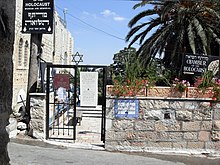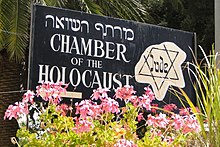Chamber of the Holocaust
31°46′16.87″N 35°13′46.21″E / 31.7713528°N 35.2295028°E

Chamber of the Holocaust (
History

The memorial was inaugurated on 30 December 1949 by the
In contrast to
Scholars have noted that the somber ambience of the museum, whose dank, cave-like rooms[9] are illuminated by candelight,[10] is meant to portray the Holocaust as a continuation of the "death and destruction" that plagued Jewish communities throughout history.[11]
Description
The museum features a large courtyard and ten exhibition rooms.
Below is an example, accompanied by a translation of the text:

In eternal memory
In memory of the souls of our dear friends, the martyrs of our city
Przedecz (Pshaytsh)
(Włocławek district)
who were murdered by the Nazis and their collaborators, may their names be obliterated
in Chełmno on the 7th day of Iyar, [5]742 [Anno Mundi], 24 April 1942
and in the other places of extermination, may God avenge their blood
The memorial day was established as the 7th day of Iyar
May their lives be bound in the bundle of the living
Their holy memory immortalized by the survivors of our city
in Israel and in the Diaspora.

Many of the museum's exhibits display religious artifacts such as a bloodstained Torah scroll from Węgrów, Poland, and a handwritten prayer book from the Buchenwald concentration camp. Other exhibits include "purses, shoe soles, drums and wallets made from the parchments of Torah scrolls",[3] a coat sewn from Torah parchments which was worn by a Nazi officer, a prisoner uniform from the Auschwitz concentration camp,[3] and a recreation of the gas oven used in the crematoria of concentration camps.[15] The museum also includes urns with the ashes of Holocaust victims from 36 Nazi death camps[16] and "RIF" soap allegedly manufactured by the Nazis from human fat.[15] There is also an exhibit on neo-Nazism with a selection of modern-day antisemitic literature.[17]
References
- ^ "Martef HaShoah". Martef HaShoah. Archived from the original on 2018-04-12. Retrieved 2018-04-12.
- ISBN 978-1780496924.
- ^ a b c d "מרתף השואה" [Chamber of the Holocaust] (in Hebrew). Jerusalem Municipality. 2008. Archived from the original on 2021-02-04. Retrieved 2012-05-11.
- S2CID 162385688.
- ISBN 978-0299234843. Archivedfrom the original on 2021-02-04. Retrieved 2021-02-04.
- ISBN 978-0820458052. Archivedfrom the original on 2021-02-04. Retrieved 2021-02-04.
- ISBN 978-3-03911-064-3. Archivedfrom the original on 2014-07-05. Retrieved 2021-02-04.
- ^ Singer, Yehudit (May 6, 2008). "60 Years of Commemorating the Holocaust". ShiurTimes: 36–37. Archived from the original on November 10, 2013. Retrieved April 20, 2012.
- ISBN 978-1416566274. Archivedfrom the original on 2021-02-04. Retrieved 2021-02-04.
- ISBN 978-0470618202. Archivedfrom the original on 2021-02-04. Retrieved 2021-02-04.
- ISBN 978-0853037231. Archivedfrom the original on 2021-02-04. Retrieved 2021-02-04.
- ^ "Chamber of the Holocaust" (in Hebrew). Ministry of Tourism, Government of Israel. Archived from the original on October 10, 2013. Retrieved May 11, 2012.
- ^ ISBN 978-0962637377. Archivedfrom the original on 2021-02-04. Retrieved 2021-02-04.
- ISBN 978-1858282480. Archivedfrom the original on 2021-02-04. Retrieved 2021-02-04.
- ^ a b "Chamber of the Holocaust Exhibitions". The Chamber of the Holocaust. Archived from the original on 4 January 2012. Retrieved 14 May 2012.
- ^ Israel; Merkaz Ha-Hasbarah, Israel; Miśrad Ha-Ḥinukh Ṿeha-Tarbut, Israel (1967). Israel government year-book. p. 331. Archived from the original on 2021-02-04. Retrieved 2021-02-04.
- ISBN 978-1858285795. Archivedfrom the original on 4 February 2021. Retrieved 25 April 2012.
External links
- Chamber of the Holocaust Official Webpage
- Chamber of the Holocaust on Facebook
- Overshadowed and overlooked, Shoah museum aims to carve niche - Times of Israel
- Visiting the Little-Known Chamber of the Holocaust - Jerusalem Post
- Chamber of the Holocaust - Go Jerusalem
